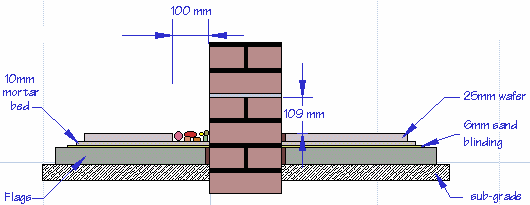Posted: Wed Jul 31, 2002 5:55 pm
Hi,
Firstly - thank you for putting together such a great site - a big relief to find Im not alone in my paving troubles! Ive read the other posts and really I just want to seek confirmation that what I am about to do is the correct thing!
Before I describe this, can I just say this is the very first time I have attempted a patio (Im more at home with PC's or wooden flooring than concrete) and Im probably being (stupid?!) by attempting to do the whole thing myself (usual budget reasons!).
Current situation:
Planned area is roughly about 2.5m by 4.5m, half of which has a set of dreadful looking flags of about 60x60 in size. I removed the top-soil in the remainder area each side to reveal concrete/compacted rubble falling away from the existing patio (ie. I will be able to use this for the new stuff, but add to it with some of my own rubble).
Problem is: Im not fit enough (slight bad back) to lift the existing flags (60x60 weigh a ton for me). Can I simply build up the surrounding area with sand/rubble, then lay the new flags (400x400x25mm!) on top of the old ones?
I assume as the new ones are so thin (typical Homebase 25mm) I cant go for the 5 cement dabs as you have mentioned in previous postings, but the sand/cement mix spread evenly is a better bet? If so, to what depth? and do i still need it spread over the area already covered by old flags, or just the rubble either side?
My assumption is that I should even-out the surrounding rubble to the level just below the existing flags, then lay the sand/cement mix (came in pre-mixed bags from homebase) over the whole area (both rubble and old-flags) with a slight gradient of 1:40, then just drop the flags straight on and hammer a little? If I can avoid cement up until pointing, I would be happier...
The existing flags which I am to lay over are 2 bricks down from the DPC, so I intend to leave a 10mm gap between the brick and new flags, and fill with.. (shingle?) like this?:
|
| |new-flag| |new-flag|
House ||old-flag| |old-flag| |old-flag| ----<grass>----
||-------rubble-------------------|-----soil---------
Oh, and this is for the back-garden - which slopes *towards* the house :( so it regularly collects puddles of water - so I will slant the flags towards the lawn (away from the house) and where the slanting lawn meets slanting paving, try to dig in a length of half-drain-pipe or similar in a feeble attempt to take the water out of the garden into the adjacent road... am I doing the right thing here as well?
Any advice/hints/tips/corrections on my assumptions or advice to stick to my day-job, extremely welcome! :)
Many thanks!
Ben
Firstly - thank you for putting together such a great site - a big relief to find Im not alone in my paving troubles! Ive read the other posts and really I just want to seek confirmation that what I am about to do is the correct thing!
Before I describe this, can I just say this is the very first time I have attempted a patio (Im more at home with PC's or wooden flooring than concrete) and Im probably being (stupid?!) by attempting to do the whole thing myself (usual budget reasons!).
Current situation:
Planned area is roughly about 2.5m by 4.5m, half of which has a set of dreadful looking flags of about 60x60 in size. I removed the top-soil in the remainder area each side to reveal concrete/compacted rubble falling away from the existing patio (ie. I will be able to use this for the new stuff, but add to it with some of my own rubble).
Problem is: Im not fit enough (slight bad back) to lift the existing flags (60x60 weigh a ton for me). Can I simply build up the surrounding area with sand/rubble, then lay the new flags (400x400x25mm!) on top of the old ones?
I assume as the new ones are so thin (typical Homebase 25mm) I cant go for the 5 cement dabs as you have mentioned in previous postings, but the sand/cement mix spread evenly is a better bet? If so, to what depth? and do i still need it spread over the area already covered by old flags, or just the rubble either side?
My assumption is that I should even-out the surrounding rubble to the level just below the existing flags, then lay the sand/cement mix (came in pre-mixed bags from homebase) over the whole area (both rubble and old-flags) with a slight gradient of 1:40, then just drop the flags straight on and hammer a little? If I can avoid cement up until pointing, I would be happier...
The existing flags which I am to lay over are 2 bricks down from the DPC, so I intend to leave a 10mm gap between the brick and new flags, and fill with.. (shingle?) like this?:
|
| |new-flag| |new-flag|
House ||old-flag| |old-flag| |old-flag| ----<grass>----
||-------rubble-------------------|-----soil---------
Oh, and this is for the back-garden - which slopes *towards* the house :( so it regularly collects puddles of water - so I will slant the flags towards the lawn (away from the house) and where the slanting lawn meets slanting paving, try to dig in a length of half-drain-pipe or similar in a feeble attempt to take the water out of the garden into the adjacent road... am I doing the right thing here as well?
Any advice/hints/tips/corrections on my assumptions or advice to stick to my day-job, extremely welcome! :)
Many thanks!
Ben
